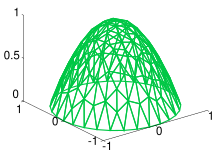
Back التقطيع Arabic Discretització Catalan Diskretizace Czech Diskretisierung German Discretización Spanish گسستهسازی Persian Discrétisation French 離散化 Japanese 이산화 Korean Discretizatio Latin

In applied mathematics, discretization is the process of transferring continuous functions, models, variables, and equations into discrete counterparts. This process is usually carried out as a first step toward making them suitable for numerical evaluation and implementation on digital computers. Dichotomization is the special case of discretization in which the number of discrete classes is 2, which can approximate a continuous variable as a binary variable (creating a dichotomy for modeling purposes, as in binary classification).
Discretization is also related to discrete mathematics, and is an important component of granular computing. In this context, discretization may also refer to modification of variable or category granularity, as when multiple discrete variables are aggregated or multiple discrete categories fused.
Whenever continuous data is discretized, there is always some amount of discretization error. The goal is to reduce the amount to a level considered negligible for the modeling purposes at hand.
The terms discretization and quantization often have the same denotation but not always identical connotations. (Specifically, the two terms share a semantic field.) The same is true of discretization error and quantization error.
Mathematical methods relating to discretization include the Euler–Maruyama method and the zero-order hold.